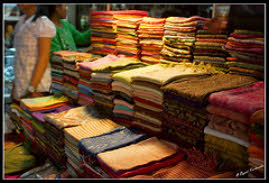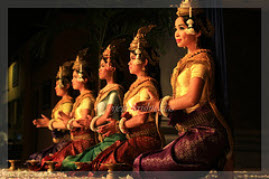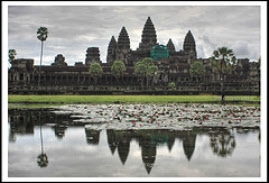by Bijesh Krishnadas
[box]Tuk-tuks, fish sauce, Apsara dancers, shopping and breathtakingly beautiful temples – Bijesh Krishnadas offers you a glimpse of Siem Reap through his words.[/box]What could be more joyful than a warm welcome that begins just as you step out of the airplane? Welcome to Siem Reap, Cambodia – the town where people practice politeness as a way of life. Right from the concierge to the tuk-tuk driver, people greet you by putting their palms together and bowing their head slightly to express their humility. It is quite ironical that you receive such a welcome in a place whose name evokes memories of sordid battles and landmines, the kind that only humans can conjure up. Siem Reap literally means the ‘death of Siam(Thailand)’. The town was wrested from Thai control in 1907 and hence the name. After such a welcome, I could digest anything that the place could throw at me.
The haphazard traffic reminds one of India and so do the motorcycles that zig-zag all over the road. Motorcycles are the de-facto motive power in Siem Reap. Here’s why. The tuk-tuk is a carriage attached to a motorcyle. There is street food served up from makeshift kitchens, towed by the motorcycle. It’s quite a sight to see three or even four people mounted on a motorcyle. And what do you know? If you are a lone traveller, you can take a moto-taxi. You do have taxis but they are not as much fun as the wind-(and rain)-on-your-face experience in a tuk-tuk. If you do get tired of the rain, your tuk-tuk driver would be more than happy to unroll the waterproof flaps that neatly keep you tucked away from the rain.
Siem Reap is a town of changing facades. The central area is touristy to the smallest detail. The sheer number of hotels in Siem Reap is awe-inspiring. Well, the more interesting fact is that every hotel has ‘Angkor’ in its name – for instance, you can find in Siem Reap the Tara Angkor or the Monica Angkor (yes, those really are names of hotels!). The central area of the town is replete with hotels, boutiques and spas, museums and markets. Interestingly, there is also the ‘Pub Street’. If you are in no mood for sight seeing, just drop by Pub Street and you are sure to have a chilled time!
Are you a foodie? Then, you have many reasons to rejoice. The food is excellent. Of course, there are many pizzerias and steak houses but nothing beats the local cuisine. I dug into the food like a ravenous caveman. Although there is an overdose of Lemongrass (which I love, by the way), the local food is simple yet with a million different flavours in them. The Cambodian cuisine has many influences mixed into it – Chinese, Indian and Thai. Most of the curries are sauce based and many stir-fried meat dishes use fish sauce. In fact, fish is the most common meat used in Siem-Reap, thanks to the meanendering waterways that run through the city. If you are a vegetarian, don’t fret! There’s quite a neat selection of veggie food too.
 It’s a shopper’s haven, Siem Reap. The Old Market and the Central Market are the perfect locations to strike brilliant bargains on everything from handbags to t-shirts to souvenirs. Just remember to bargain though. With the right amount of bargaining, prices can be brought down by as much amount of skill, prices can be brought down by as much as 80%! While bargaining isn’t exactly something I’m good at, the prices I paid were much lower than what was first quoted. Silk products are the most popular and the most in demand. They come in all forms like scarves, wall hangings and clothes. Temple rubbings are another popular souvenir. These are charcoal rubbings but are not really from the temples. Instead these are rubbed from recreated carvings.
It’s a shopper’s haven, Siem Reap. The Old Market and the Central Market are the perfect locations to strike brilliant bargains on everything from handbags to t-shirts to souvenirs. Just remember to bargain though. With the right amount of bargaining, prices can be brought down by as much amount of skill, prices can be brought down by as much as 80%! While bargaining isn’t exactly something I’m good at, the prices I paid were much lower than what was first quoted. Silk products are the most popular and the most in demand. They come in all forms like scarves, wall hangings and clothes. Temple rubbings are another popular souvenir. These are charcoal rubbings but are not really from the temples. Instead these are rubbed from recreated carvings.Right Ho! Shopping done! Now gear up to watch the Apsara dances!. Apsaras are from Hindu mythology and are the celestial dancers who performed in the courts of gods. In fact, they are an ever-present theme throughout Angkor; it is said that there are thousands of statues and bas reliefs of Apsaras in Angkor Wat, the world-famous temple about 6 km north of Siem Reap. The dance was originally a ballet performed for royalty in the courts of the king and draws inspiration from Indian dance forms. The movements are gentle and unhurried and the stories are conveyed through gestures. The dancers never sing and only a slight smile adorns their beautiful faces throughout the performance, leaving the audience in a state of pleasant peace. While indulging in all the fun activites and the local culture, let’s not forget the reason people visit Siem Reap – the temples. Many of these temples were originally built to be Hindu temples. Around the late 13th century, the then king Srindravarman set in motion the kingdom’s conversion to Buddhism. The temples still bear the memories of this conversion – one can find beheaded statues of Hindu gods and sometimes even sections entirely rebuilt.
performed in the courts of gods. In fact, they are an ever-present theme throughout Angkor; it is said that there are thousands of statues and bas reliefs of Apsaras in Angkor Wat, the world-famous temple about 6 km north of Siem Reap. The dance was originally a ballet performed for royalty in the courts of the king and draws inspiration from Indian dance forms. The movements are gentle and unhurried and the stories are conveyed through gestures. The dancers never sing and only a slight smile adorns their beautiful faces throughout the performance, leaving the audience in a state of pleasant peace. While indulging in all the fun activites and the local culture, let’s not forget the reason people visit Siem Reap – the temples. Many of these temples were originally built to be Hindu temples. Around the late 13th century, the then king Srindravarman set in motion the kingdom’s conversion to Buddhism. The temples still bear the memories of this conversion – one can find beheaded statues of Hindu gods and sometimes even sections entirely rebuilt.
 performed in the courts of gods. In fact, they are an ever-present theme throughout Angkor; it is said that there are thousands of statues and bas reliefs of Apsaras in Angkor Wat, the world-famous temple about 6 km north of Siem Reap. The dance was originally a ballet performed for royalty in the courts of the king and draws inspiration from Indian dance forms. The movements are gentle and unhurried and the stories are conveyed through gestures. The dancers never sing and only a slight smile adorns their beautiful faces throughout the performance, leaving the audience in a state of pleasant peace. While indulging in all the fun activites and the local culture, let’s not forget the reason people visit Siem Reap – the temples. Many of these temples were originally built to be Hindu temples. Around the late 13th century, the then king Srindravarman set in motion the kingdom’s conversion to Buddhism. The temples still bear the memories of this conversion – one can find beheaded statues of Hindu gods and sometimes even sections entirely rebuilt.
performed in the courts of gods. In fact, they are an ever-present theme throughout Angkor; it is said that there are thousands of statues and bas reliefs of Apsaras in Angkor Wat, the world-famous temple about 6 km north of Siem Reap. The dance was originally a ballet performed for royalty in the courts of the king and draws inspiration from Indian dance forms. The movements are gentle and unhurried and the stories are conveyed through gestures. The dancers never sing and only a slight smile adorns their beautiful faces throughout the performance, leaving the audience in a state of pleasant peace. While indulging in all the fun activites and the local culture, let’s not forget the reason people visit Siem Reap – the temples. Many of these temples were originally built to be Hindu temples. Around the late 13th century, the then king Srindravarman set in motion the kingdom’s conversion to Buddhism. The temples still bear the memories of this conversion – one can find beheaded statues of Hindu gods and sometimes even sections entirely rebuilt.In the hot, humid weather it took me two days to explore the temples and yet I did not even glance at many of them. Although Angkor Wat is the most famous of the temples, there are many other temples – small and big – that are worth a visit. Very close to Angkor Wat is Angkor Thom, which was a city in itself. Bounded by a wall and moats, Angkor Thom occupies an area of about 9 sq. Km and contains many temples within, with the Bayon temple at the centre.

Most of the temples in Angkor are in ruins, thanks to the architectural technique. If you look closely, you will see that the stones that make up the structures are carved to fit one another and there is no binding of any sort to hold them together.
Naturally the buildings could not withstand the ravages of time and weather and began to crumble. At the moment, work is on in full steam to restore the temples to their past glory but it is tedious work. The buildings have to be disassembled first, indexing each stone and its original position. The next step would be to put them back together after fixing up all the niggles and leaks in the foundation and other parts of the structure. This is likely to take years. All the same, the monuments leave you with that touch of the past. Just try and ignore the sellers who will follow you everywhere. Of course, the shopaholic could choose to buy, buy, buy.
Siem Reap impresses you with the politeness of its people, the shopping variety it offers and above all, its architectural beauty. Now that I have done the touristy thing, I wish to return to Cambodia someday to explore the country and its people. I am sure I would not find the welcome lacking. And if you are planning to pack your bags for a memorable vacation, then Siem Reap is a place worth considering!
Pictures by Bijesh Krishnadas
[facebook]Share this on Facebook[/facebook]
[retweet]Tweet this[/retweet]




